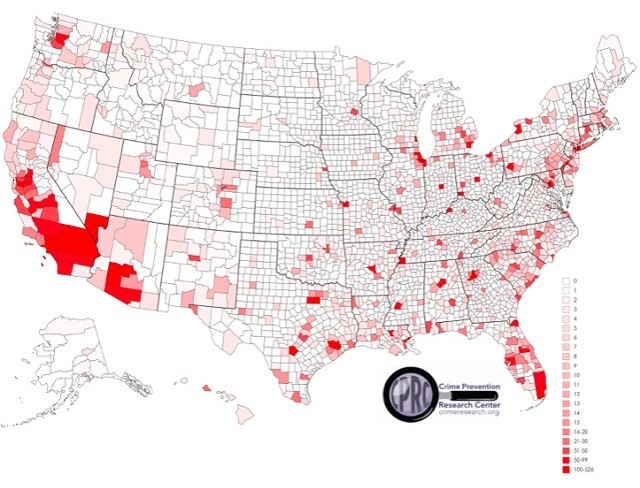Research Shows Murders are Heavily Concentrated in Small Fraction of Counties
This week, a new report from the Crime Prevention Research Center (CPRC) revealed just how concentrated murders are in the U.S. Citing county level data from 2014, researchers determined that a small fraction of all counties are responsible for a majority of the murders in the U.S.
According to the report, just 2 percent of all of the counties in the country account for 51 percent of the nation’s murders. The top 5 percent of counties account for 68 percent of all murders. Further, 69 percent of all counties experienced one murder or less in 2014.

It is correct to expect that counties with large population centers are going to necessarily account for more murders. However, as the report details, the most dangerous counties account for an outsized proportion of murders given their population. The report noted,
“The worst 1% of counties have 19% of the population and 37% of the murders. The worst 5% of counties contain 47% of the population and account for 68% of murders.”
CPRC also pointed out that murders are often highly concentrated within a given county. Citing Los Angeles County, which experienced 526 murder in 2014, CPRC showed that there were wide swaths of the county with virtually no murders.
CPRC’s data dovetails with other research on the concentration of criminal violence. In recent years, researchers from Yale University have studied the concentration of violence in certain social networks. In a 2015 piece for the Hartford Courant that succinctly outlines some of this research, Yale Ph.D. candidate Michael Sierra-Arévalo explained that Yale University sociologists determined “70 percent of all shootings in Chicago can be located in a social network composed of less than 6 percent of the city’s population.”
Sierra-Arévalo also cited a study from researchers at Harvard and Yale, that examined violence perpetrated with guns in Boston. This research showed that violence is heavily concentrated even within a given city, determining that “between 1980 and 2009, 89 percent of Boston streets never experienced an episode of gun violence,” and that “more than half of all the gun violence during the almost 30-year period occurred in only 5 percent of the city’s streets.”
Given that criminal violence is highly concentrated, efforts to tackle this discrete problem with ham-handed restrictions on the conduct of the public at large are inappropriate. Rather than further burden the law-abiding, federal, state, and local officials should target known areas of violence with vigorous enforcement of existing state and federal law.



I would be interested in the demographics of these trouble spots.